An approach to solve the problem of data fusion for multi - target tracking using fuzzy logic
Most of the multitarget tracking (MTT) algorithms have been developed for the
applications of the transportation and air traffic control. However, the maneuvering
conditions of object, the clutters within surveillance radar areas make tracking
problem quite difficult [2]. The filtering, tracking to the trajectories of objects and
the data fusion can be considered two sides of a problem. In fact, the design of an
MTT algorithm in such a surveillance environment poses a challenging problem.
One difficulty in MTT is data fusion (DF) [2÷4], especially in maneuvering targets
tracking in the clutter environment. The probabilistic data fusion (PDF) [4, 6, 11]
and joint probabilistic data fusion (JPDF) [6, 11] are conventionally used along
with Kalman filters. However, in either dense target or cluttered environment,
radar observations are degraded and this degrades target tracking performance.
In this paper the Kalman filter and the fuzzy data fusion (FDF) are proposed to
improve the tracking performance. The algorithm uses the fuzzy “ IF THEN ”
rules for multitarget data fusion under a high cluttered environment [10, 14].
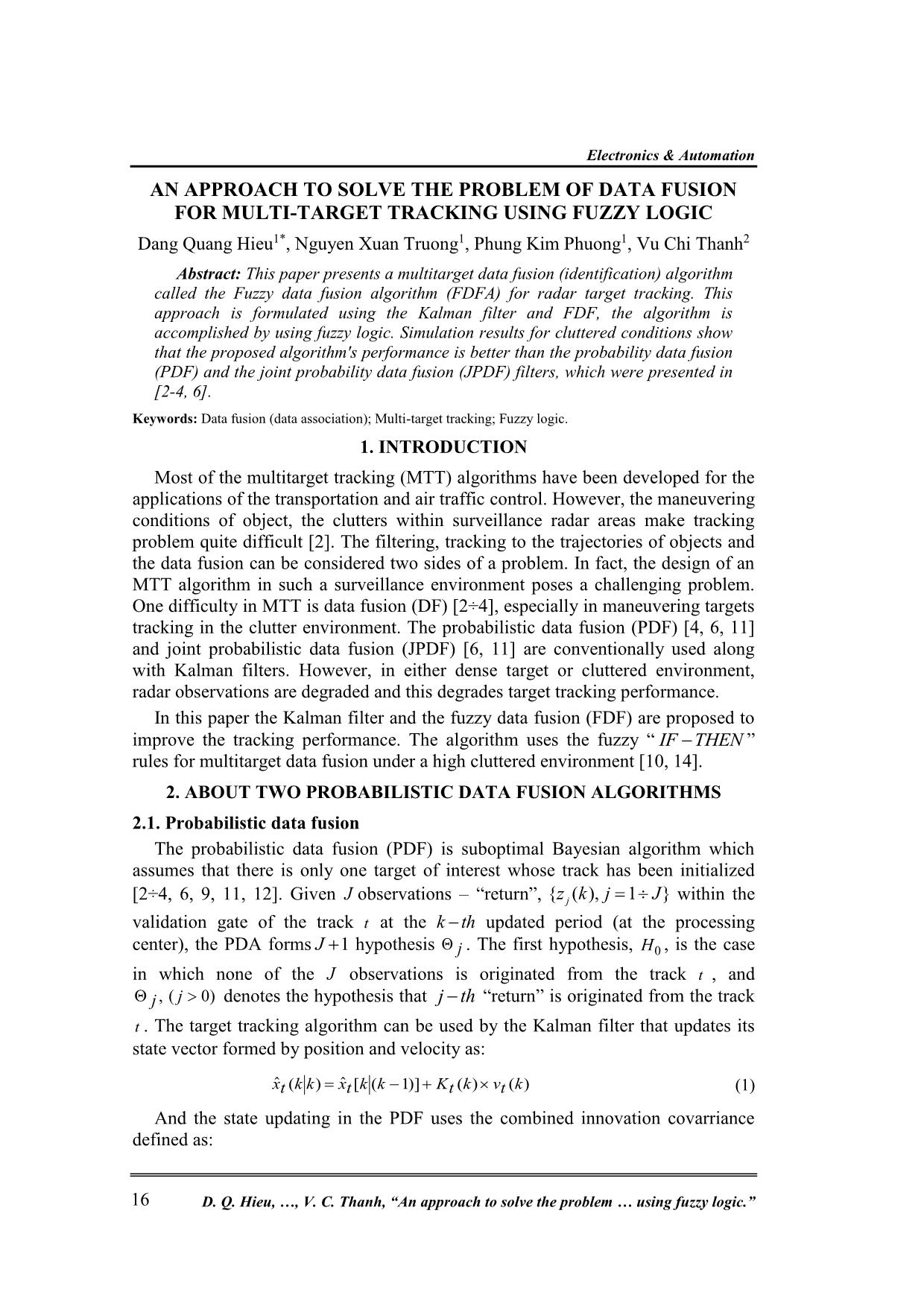
Trang 1
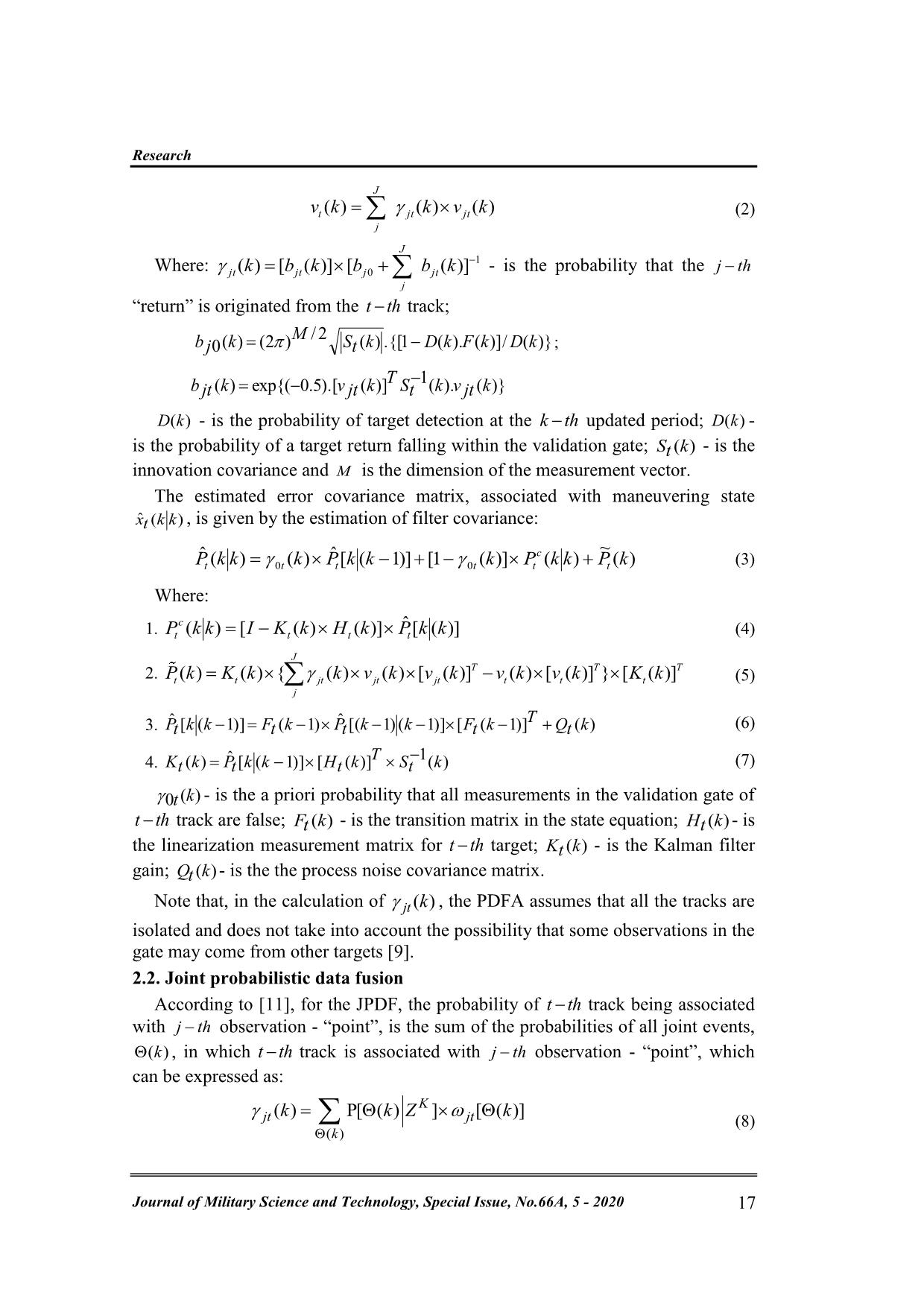
Trang 2
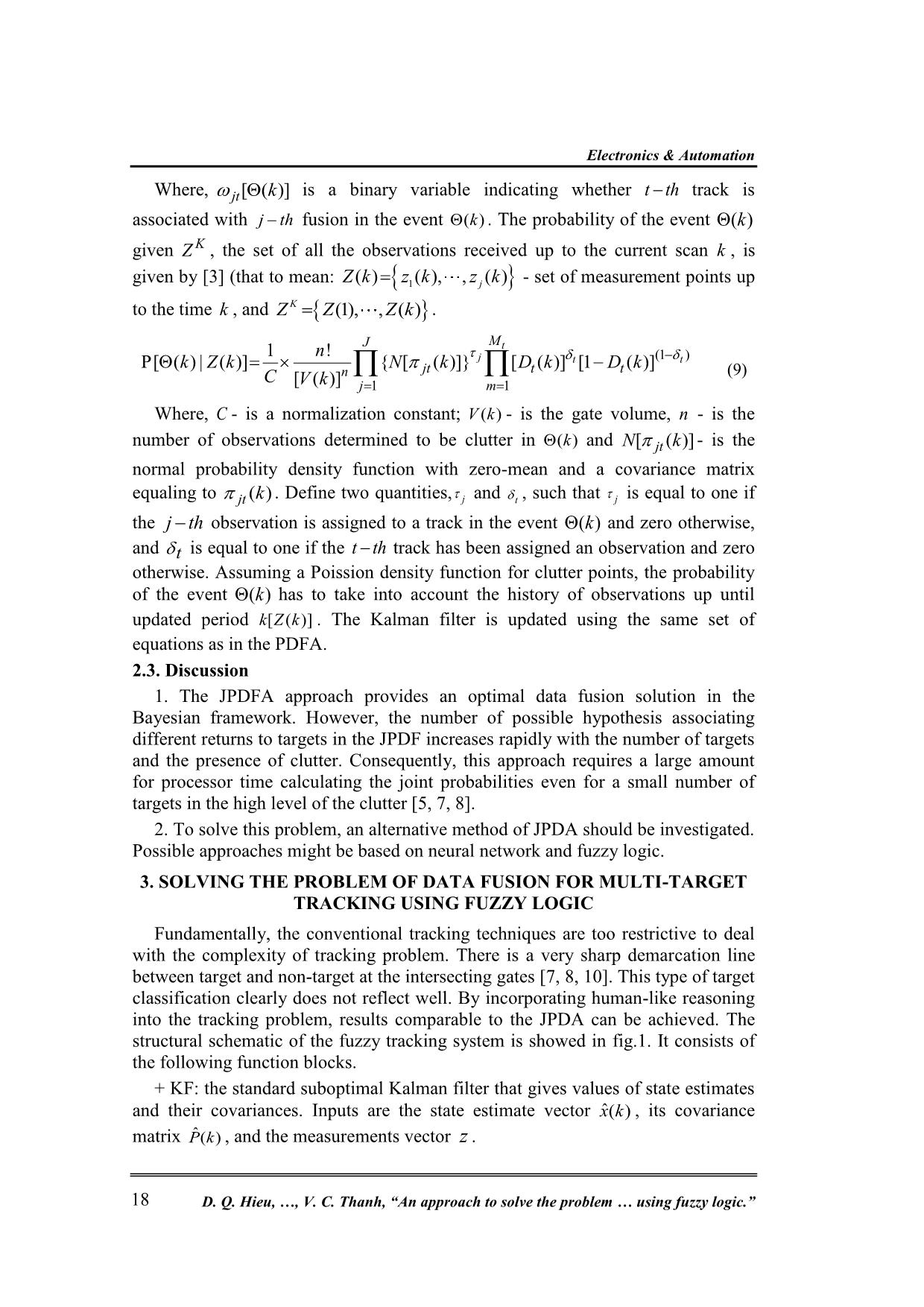
Trang 3
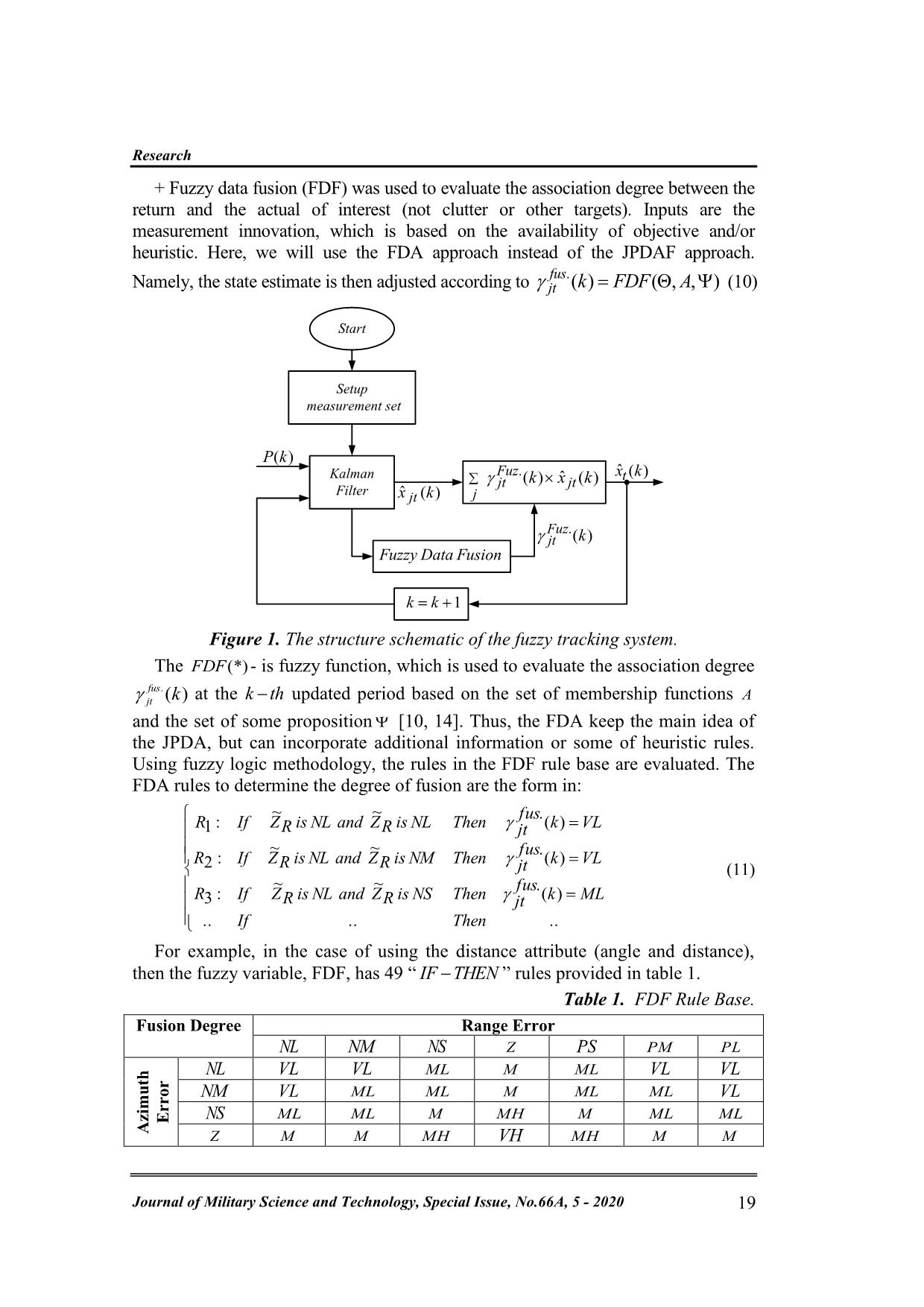
Trang 4
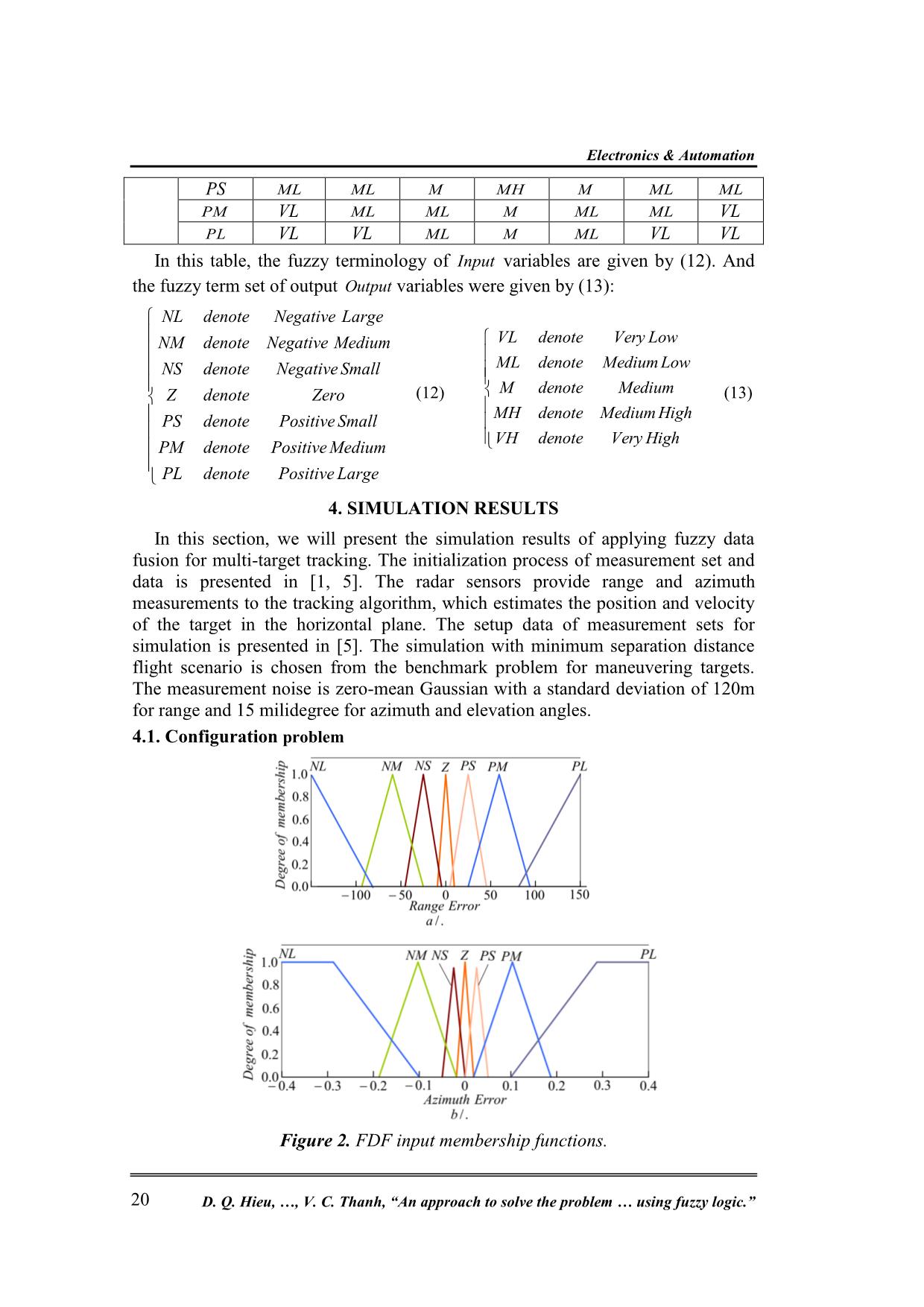
Trang 5
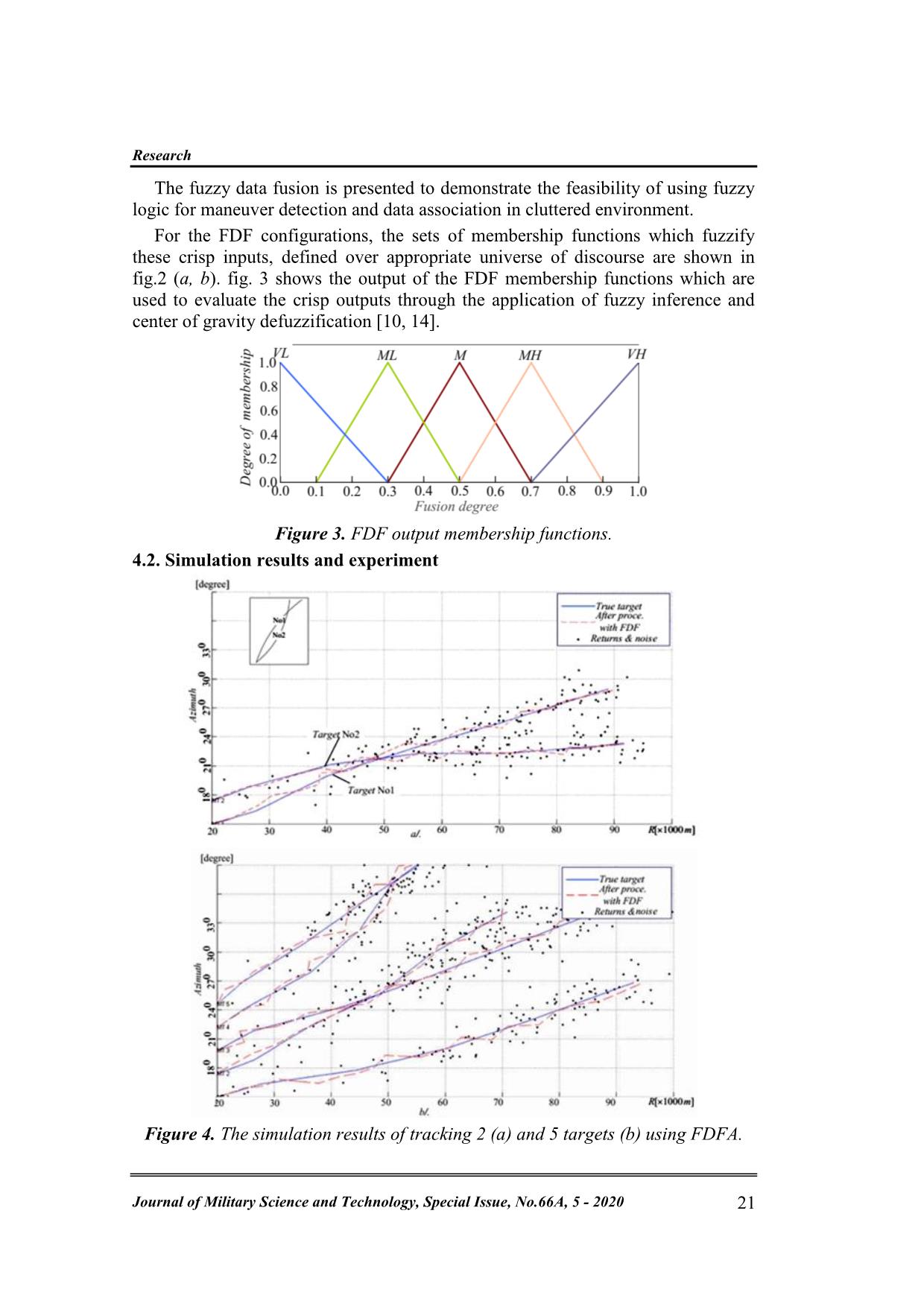
Trang 6
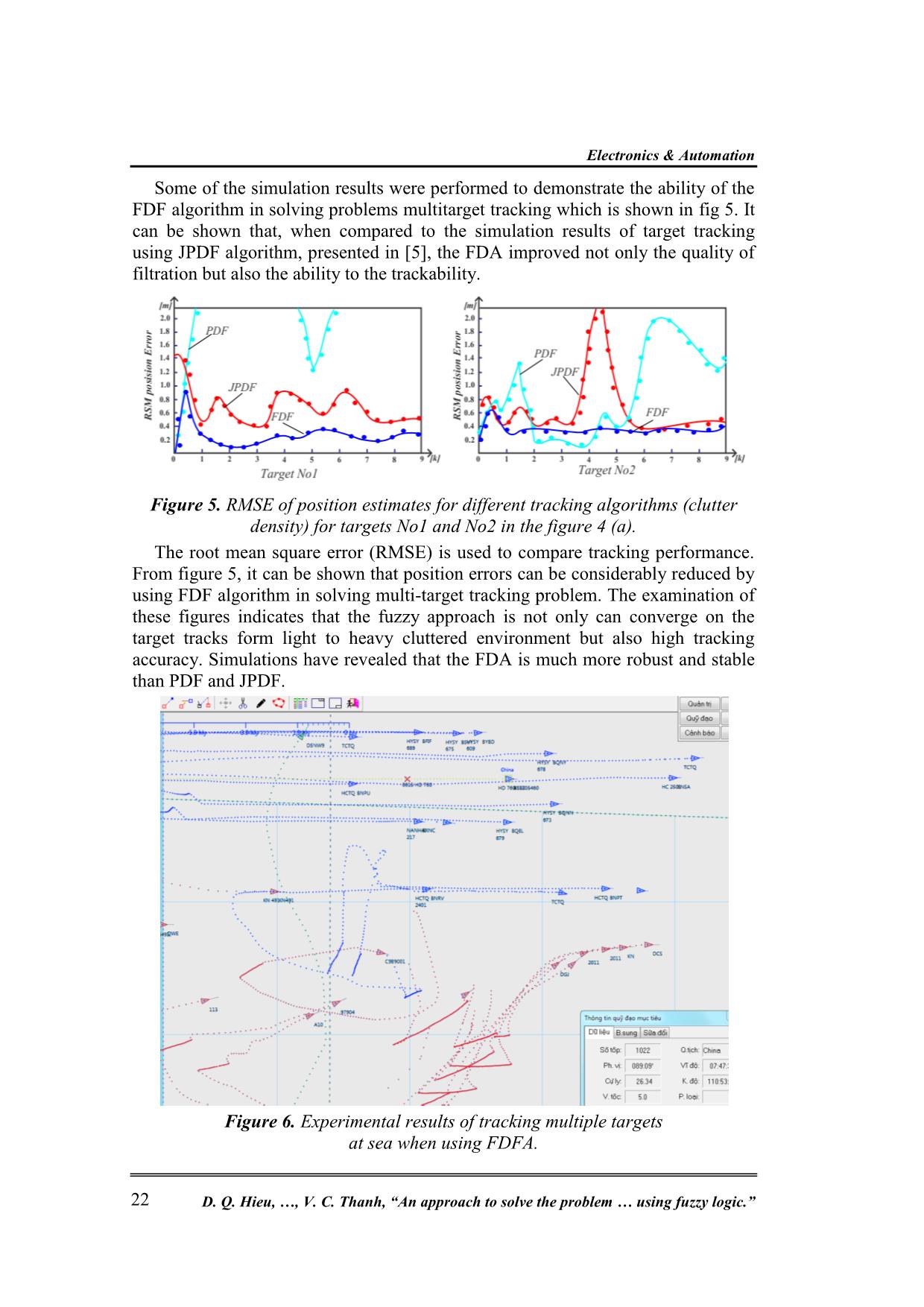
Trang 7
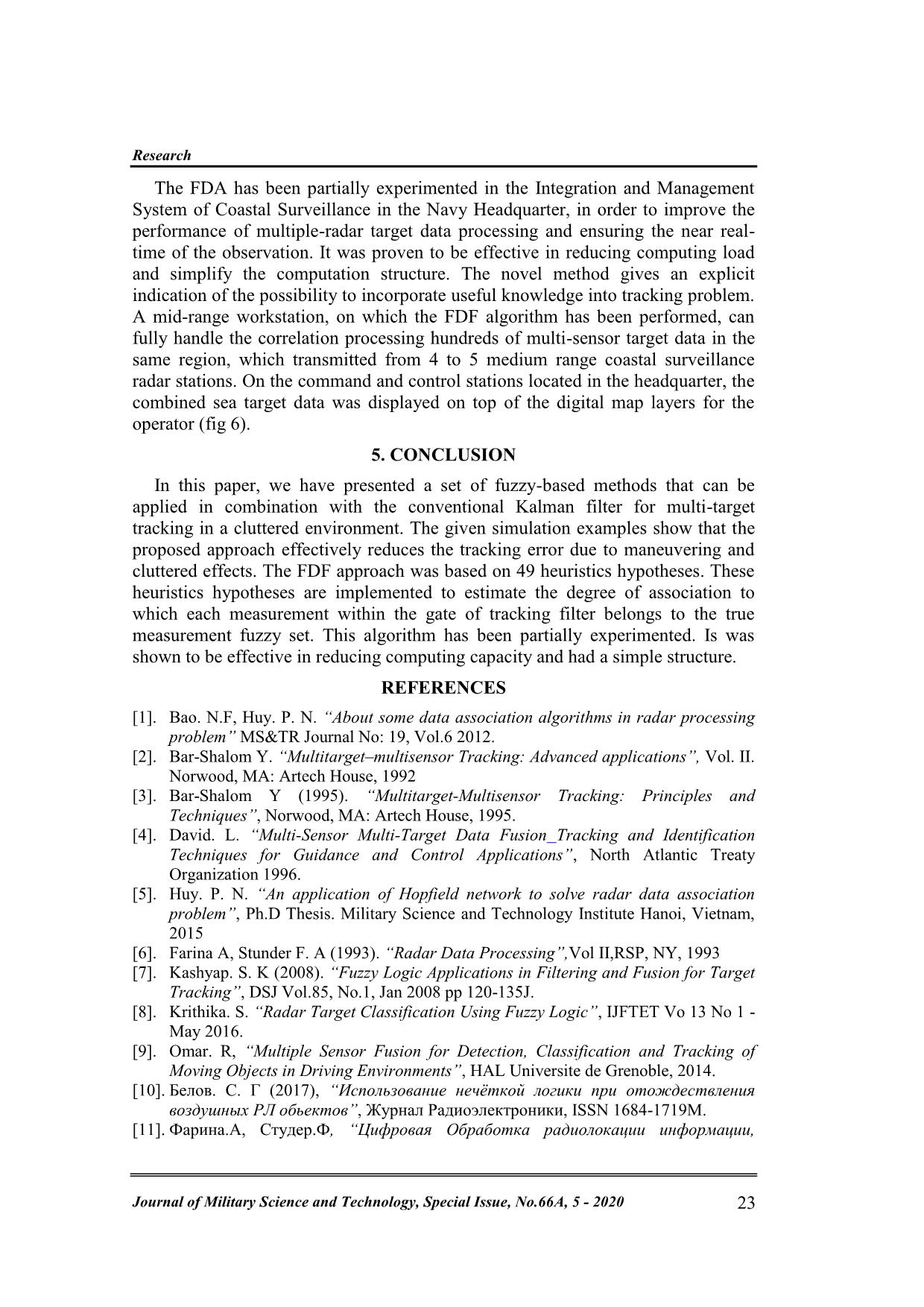
Trang 8
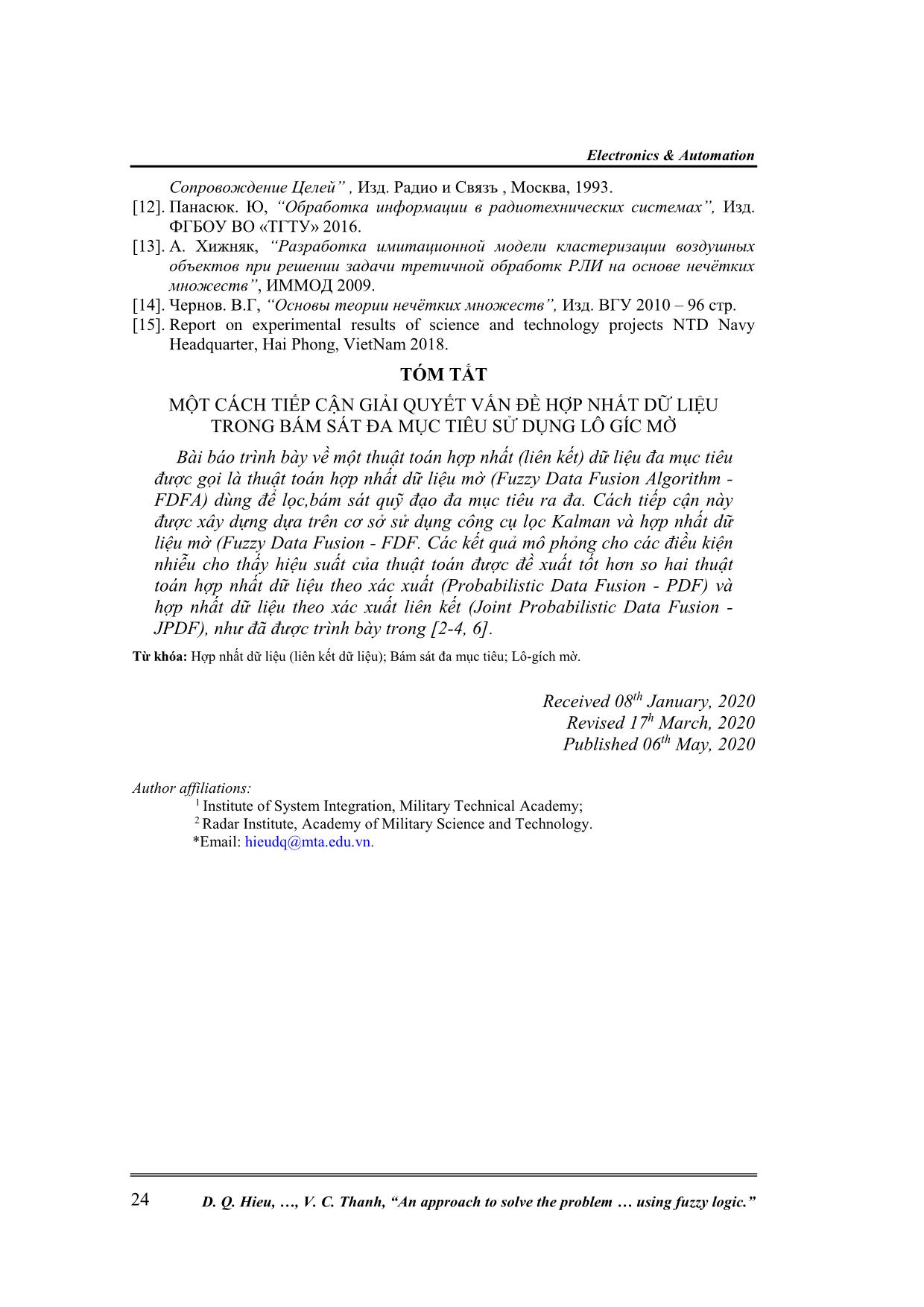
Trang 9
Tóm tắt nội dung tài liệu: An approach to solve the problem of data fusion for multi - target tracking using fuzzy logic
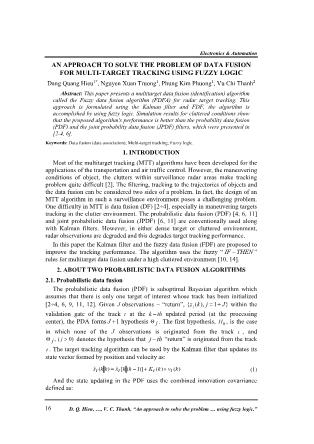
Special Issue, No.66A, 5 - 2020 17
)()()( kvkkv jtjt
J
j
t (2)
Where: 10 )]([)]([)(
kbbkbk jt
J
j
jjtjt - is the probability that the thj
“return” is originated from the tht track;
)}(/)]().(1.{[)(
2/)2()(0 kDkFkDktS
Mkjb ;
)}().(1)]().[5.0exp{()( kjtvktS
Tkjtvkjtb
)(kD - is the probability of target detection at the thk updated period; )(kD -
is the probability of a target return falling within the validation gate; )(ktS - is the
innovation covariance and M is the dimension of the measurement vector.
The estimated error covariance matrix, associated with maneuvering state
)(ˆ kktx , is given by the estimation of filter covariance:
)(
~
)()](1[)]1([ˆ)()(ˆ 00 kPkkPkkkPkkkP t
c
ttttt (3)
Where:
1. )]([ˆ)]()([)( kkPkHkKIkkP ttt
c
t (4)
2. ( ) ( ) { ( ) ( ) [ ( )] ( ) [ ( )] } [ ( )]
J
T T T
t t jt jt jt t t t
j
P k K k k v k v k v k v k K k (5)
3. )()]1([)]1()1[(ˆ)1()]1([ˆ ktQ
TktFkktPktFkktP (6)
4. )(
1)]([)]1([ˆ)( ktS
TktHkktPktK
(7)
)(0 kt - is the a priori probability that all measurements in the validation gate of
tht track are false; )(ktF - is the transition matrix in the state equation; )(ktH - is
the linearization measurement matrix for tht target; )(ktK - is the Kalman filter
gain; )(ktQ - is the the process noise covariance matrix.
Note that, in the calculation of ( )jt k , the PDFA assumes that all the tracks are
isolated and does not take into account the possibility that some observations in the
gate may come from other targets [9].
2.2. Joint probabilistic data fusion
According to [11], for the JPDF, the probability of tht track being associated
with thj observation - “point”, is the sum of the probabilities of all joint events,
)(k , in which tht track is associated with thj observation - “point”, which
can be expressed as:
( )
( ) P[ ( ) ] [ ( )]Kjt jt
k
k k Z k
(8)
Electronics & Automation
D. Q. Hieu, , V. C. Thanh, “An approach to solve the problem using fuzzy logic.” 18
Where, [ ( )]jt k is a binary variable indicating whether tht track is
associated with thj fusion in the event )(k . The probability of the event ( )k
given KZ , the set of all the observations received up to the current scan k , is
given by [3] (that to mean: 1( ) ( ), , ( )jZ k z k z k - set of measurement points up
to the time k , and (1), , ( )KZ Z Z k .
(1 )
1 1
1 !
[ ( ) | ( )] { [ ( )]} [ ( )] [1 ( )]
[ ( )]
t
j t t
MJ
jt t tn
j m
n
k Z k N k D k D k
C V k
(9)
Where, C - is a normalization constant; )(kV - is the gate volume, n - is the
number of observations determined to be clutter in )(k and [ ( )]jtN k - is the
normal probability density function with zero-mean and a covariance matrix
equaling to ( )jt k . Define two quantities, j and t , such that j is equal to one if
the j th observation is assigned to a track in the event ( )k and zero otherwise,
and t is equal to one if the tht track has been assigned an observation and zero
otherwise. Assuming a Poission density function for clutter points, the probability
of the event ( )k has to take into account the history of observations up until
updated period )]([ kZk . The Kalman filter is updated using the same set of
equations as in the PDFA.
2.3. Discussion
1. The JPDFA approach provides an optimal data fusion solution in the
Bayesian framework. However, the number of possible hypothesis associating
different returns to targets in the JPDF increases rapidly with the number of targets
and the presence of clutter. Consequently, this approach requires a large amount
for processor time calculating the joint probabilities even for a small number of
targets in the high level of the clutter [5, 7, 8].
2. To solve this problem, an alternative method of JPDA should be investigated.
Possible approaches might be based on neural network and fuzzy logic.
3. SOLVING THE PROBLEM OF DATA FUSION FOR MULTI-TARGET
TRACKING USING FUZZY LOGIC
Fundamentally, the conventional tracking techniques are too restrictive to deal
with the complexity of tracking problem. There is a very sharp demarcation line
between target and non-target at the intersecting gates [7, 8, 10]. This type of target
classification clearly does not reflect well. By incorporating human-like reasoning
into the tracking problem, results comparable to the JPDA can be achieved. The
structural schematic of the fuzzy tracking system is showed in fig.1. It consists of
the following function blocks.
+ KF: the standard suboptimal Kalman filter that gives values of state estimates
and their covariances. Inputs are the state estimate vector )(ˆ kx , its covariance
matrix )(ˆ kP , and the measurements vector z .
Research
Journal of Military Science and Technology, Special Issue, No.66A, 5 - 2020 19
+ Fuzzy data fusion (FDF) was used to evaluate the association degree between the
return and the actual of interest (not clutter or other targets). Inputs are the
measurement innovation, which is based on the availability of objective and/or
heuristic. Here, we will use the FDA approach instead of the JPDAF approach.
Namely, the state estimate is then adjusted according to
.
( ) ( , , )
fus
jt k FDF A (10)
Kalman
Filter
Start
Setup
measurement set
FusionDataFuzzy
)(. kFuzjt
)(ˆ kx jt
)(ˆ)(. kxk jt
Fuz
jt
j
1 kk
)(ˆ kxt
)(kP
Figure 1. The structure schematic of the fuzzy tracking system.
The (*)FDF - is fuzzy function, which is used to evaluate the association degree
.( )fus
jt
k at the thk updated period based on the set of membership functions A
and the set of some proposition [10, 14]. Thus, the FDA keep the main idea of
the JPDA, but can incorporate additional information or some of heuristic rules.
Using fuzzy logic methodology, the rules in the FDF rule base are evaluated. The
FDA rules to determine the degree of fusion are the form in:
......
)(
.~~
:3
)(
.~~
:2
)(
.~~
:1
ThenIf
MLk
fus
jtThenNSisRZandNLisRZIfR
VLk
fus
jtThenNMisRZandNLisRZIfR
VLk
fus
jtThenNLisRZandNLisRZIfR
(11)
For example, in the case of using the distance attribute (angle and distance),
then the fuzzy variable, FDF, has 49 “ THENIF ” rules provided in table 1.
Table 1. FDF Rule Base.
Fusion Degree Range Error
NL NM NS Z PS PM PL
A
zi
m
u
th
E
rr
o
r
NL VL VL ML M ML VL VL
NM VL ML ML M ML ML VL
NS ML ML M MH M ML ML
Z M M MH VH MH M M
Electronics & Automation
D. Q. Hieu, , V. C. Thanh, “An approach to solve the problem using fuzzy logic.” 20
PS ML ML M MH M ML ML
PM VL ML ML M ML ML VL
PL VL VL ML M ML VL VL
In this table, the fuzzy terminology of Input variables are given by (12). And
the fuzzy term set of output Output variables were given by (13):
NL denote Negative Large
NM denote Negative Medium
NS denote Negative Small
Z denote Zero
PS denote Positive Small
PM denote Positive Medium
PL denote Positive Large
(12)
HighVerydenoteVH
HighMediumdenoteMH
MediumdenoteM
LowMediumdenoteML
LowVerydenoteVL
(13)
4. SIMULATION RESULTS
In this section, we will present the simulation results of applying fuzzy data
fusion for multi-target tracking. The initialization process of measurement set and
data is presented in [1, 5]. The radar sensors provide range and azimuth
measurements to the tracking algorithm, which estimates the position and velocity
of the target in the horizontal plane. The setup data of measurement sets for
simulation is presented in [5]. The simulation with minimum separation distance
flight scenario is chosen from the benchmark problem for maneuvering targets.
The measurement noise is zero-mean Gaussian with a standard deviation of 120m
for range and 15 milidegree for azimuth and elevation angles.
4.1. Configuration problem
Figure 2. FDF input membership functions.
Research
Journal of Military Science and Technology, Special Issue, No.66A, 5 - 2020 21
The fuzzy data fusion is presented to demonstrate the feasibility of using fuzzy
logic for maneuver detection and data association in cluttered environment.
For the FDF configurations, the sets of membership functions which fuzzify
these crisp inputs, defined over appropriate universe of discourse are shown in
fig.2 (a, b). fig. 3 shows the output of the FDF membership functions which are
used to evaluate the crisp outputs through the application of fuzzy inference and
center of gravity defuzzification [10, 14].
Figure 3. FDF output membership functions.
4.2. Simulation results and experiment
Figure 4. The simulation results of tracking 2 (a) and 5 targets (b) using FDFA.
Electronics & Automation
D. Q. Hieu, , V. C. Thanh, “An approach to solve the problem using fuzzy logic.” 22
Some of the simulation results were performed to demonstrate the ability of the
FDF algorithm in solving problems multitarget tracking which is shown in fig 5. It
can be shown that, when compared to the simulation results of target tracking
using JPDF algorithm, presented in [5], the FDA improved not only the quality of
filtration but also the ability to the trackability.
Figure 5. RMSE of position estimates for different tracking algorithms (clutter
density) for targets No1 and No2 in the figure 4 (a).
The root mean square error (RMSE) is used to compare tracking performance.
From figure 5, it can be shown that position errors can be considerably reduced by
using FDF algorithm in solving multi-target tracking problem. The examination of
these figures indicates that the fuzzy approach is not only can converge on the
target tracks form light to heavy cluttered environment but also high tracking
accuracy. Simulations have revealed that the FDA is much more robust and stable
than PDF and JPDF.
Figure 6. Experimental results of tracking multiple targets
at sea when using FDFA.
Research
Journal of Military Science and Technology, Special Issue, No.66A, 5 - 2020 23
The FDA has been partially experimented in the Integration and Management
System of Coastal Surveillance in the Navy Headquarter, in order to improve the
performance of multiple-radar target data processing and ensuring the near real-
time of the observation. It was proven to be effective in reducing computing load
and simplify the computation structure. The novel method gives an explicit
indication of the possibility to incorporate useful knowledge into tracking problem.
A mid-range workstation, on which the FDF algorithm has been performed, can
fully handle the correlation processing hundreds of multi-sensor target data in the
same region, which transmitted from 4 to 5 medium range coastal surveillance
radar stations. On the command and control stations located in the headquarter, the
combined sea target data was displayed on top of the digital map layers for the
operator (fig 6).
5. CONCLUSION
In this paper, we have presented a set of fuzzy-based methods that can be
applied in combination with the conventional Kalman filter for multi-target
tracking in a cluttered environment. The given simulation examples show that the
proposed approach effectively reduces the tracking error due to maneuvering and
cluttered effects. The FDF approach was based on 49 heuristics hypotheses. These
heuristics hypotheses are implemented to estimate the degree of association to
which each measurement within the gate of tracking filter belongs to the true
measurement fuzzy set. This algorithm has been partially experimented. Is was
shown to be effective in reducing computing capacity and had a simple structure.
REFERENCES
[1]. Bao. N.F, Huy. P. N. “About some data association algorithms in radar processing
problem” MS&TR Journal No: 19, Vol.6 2012.
[2]. Bar-Shalom Y. “Multitarget–multisensor Tracking: Advanced applications”, Vol. II.
Norwood, MA: Artech House, 1992
[3]. Bar-Shalom Y (1995). “Multitarget-Multisensor Tracking: Principles and
Techniques”, Norwood, MA: Artech House, 1995.
[4]. David. L. “Multi-Sensor Multi-Target Data Fusion Tracking and Identification
Techniques for Guidance and Control Applications”, North Atlantic Treaty
Organization 1996.
[5]. Huy. P. N. “An application of Hopfield network to solve radar data association
problem”, Ph.D Thesis. Military Science and Technology Institute Hanoi, Vietnam,
2015
[6]. Farina A, Stunder F. A (1993). “Radar Data Processing”,Vol II,RSP, NY, 1993
[7]. Kashyap. S. K (2008). “Fuzzy Logic Applications in Filtering and Fusion for Target
Tracking”, DSJ Vol.85, No.1, Jan 2008 pp 120-135J.
[8]. Krithika. S. “Radar Target Classification Using Fuzzy Logic”, IJFTET Vo 13 No 1 -
May 2016.
[9]. Omar. R, “Multiple Sensor Fusion for Detection, Classification and Tracking of
Moving Objects in Driving Environments”, HAL Universite de Grenoble, 2014.
[10]. Белов. С. Г (2017), “Использование нечёткой логики при отождествления
воздушных РЛ обьектов”, Журнал Радиоэлектроники, ISSN 1684-1719M.
[11]. Фарина.A, Cтудер.Ф, “Цифровая Обработка радиолокации информации,
Electronics & Automation
D. Q. Hieu, , V. C. Thanh, “An approach to solve the problem using fuzzy logic.” 24
Сопровождение Целей” , Изд. Радио и Связъ , Москва, 1993.
[12]. Панасюк. Ю, “Обработка информации в радиотехнических системах”, Изд.
ФГБОУ ВО «ТГТУ» 2016.
[13]. А. Хижняк, “Разработка имитационной модели кластеризации воздушных
объектов при решении задачи третичной обработк РЛИ на основе нечётких
множеств”, ИММОД 2009.
[14]. Чернов. В.Г, “Основы теории нечётких множеств”, Изд. ВГУ 2010 – 96 стр.
[15]. Report on experimental results of science and technology projects NTD Navy
Headquarter, Hai Phong, VietNam 2018.
TÓM TẮT
MỘT CÁCH TIẾP CẬN GIẢI QUYẾT VẤN ĐỀ HỢP NHẤT DỮ LIỆU
TRONG BÁM SÁT ĐA MỤC TIÊU SỬ DỤNG LÔ GÍC MỜ
Bài báo trình bày về một thuật toán hợp nhất (liên kết) dữ liệu đa mục tiêu
được gọi là thuật toán hợp nhất dữ liệu mờ (Fuzzy Data Fusion Algorithm -
FDFA) dùng để lọc,bám sát quỹ đạo đa mục tiêu ra đa. Cách tiếp cận này
được xây dựng dựa trên cơ sở sử dụng công cụ lọc Kalman và hợp nhất dữ
liệu mờ (Fuzzy Data Fusion - FDF. Các kết quả mô phỏng cho các điều kiện
nhiễu cho thấy hiệu suất của thuật toán được đề xuất tốt hơn so hai thuật
toán hợp nhất dữ liệu theo xác xuất (Probabilistic Data Fusion - PDF) và
hợp nhất dữ liệu theo xác xuất liên kết (Joint Probabilistic Data Fusion -
JPDF), như đã được trình bày trong [2-4, 6].
Từ khóa: Hợp nhất dữ liệu (liên kết dữ liệu); Bám sát đa mục tiêu; Lô-gích mờ.
Received 08th January, 2020
Revised 17h March, 2020
Published 06th May, 2020
Author affiliations:
1 Institute of System Integration, Military Technical Academy;
2 Radar Institute, Academy of Military Science and Technology.
*Email: hieudq@mta.edu.vn.
File đính kèm:
 an_approach_to_solve_the_problem_of_data_fusion_for_multi_ta.pdf
an_approach_to_solve_the_problem_of_data_fusion_for_multi_ta.pdf

